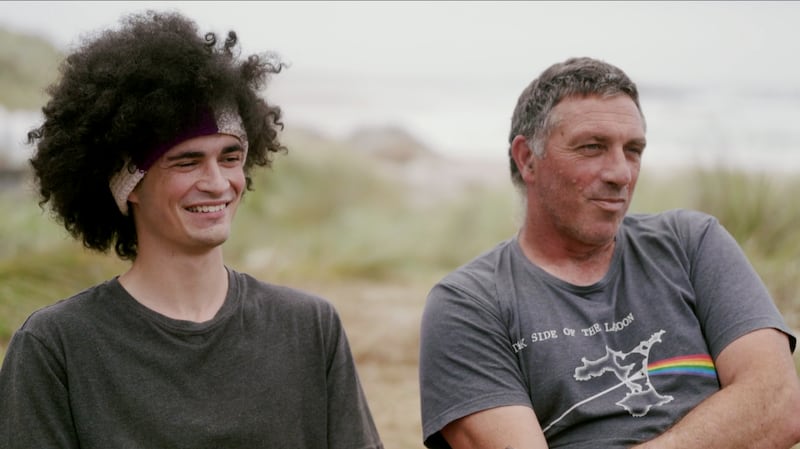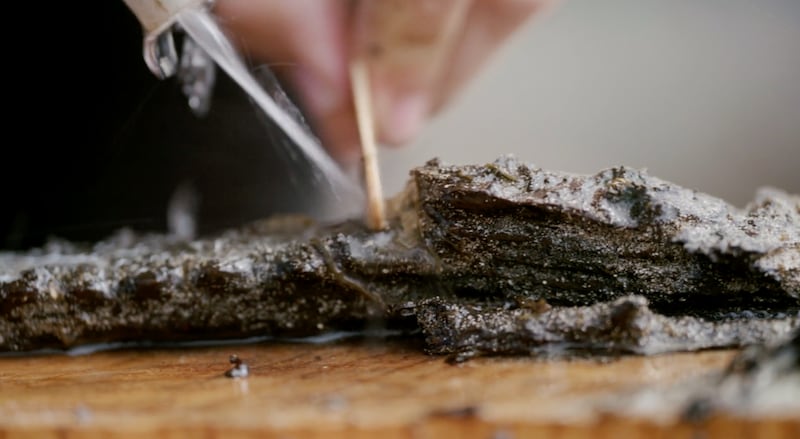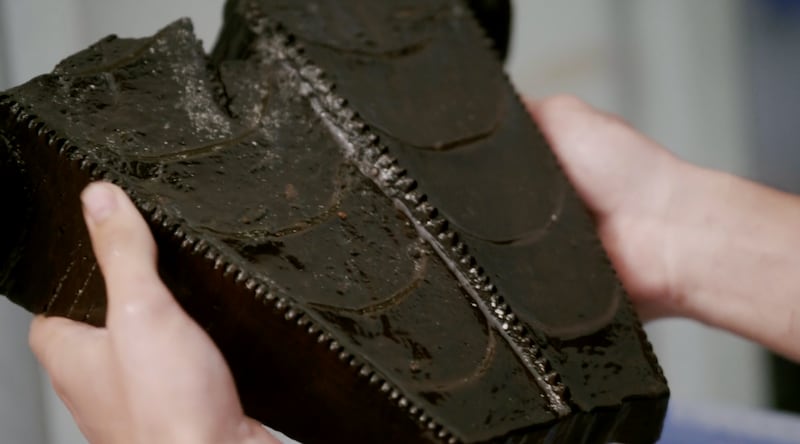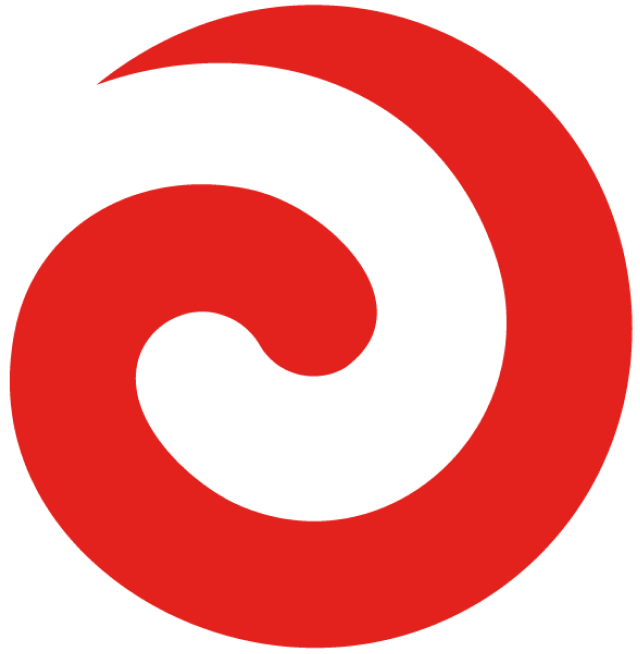Until now, the archaeological dig and key personalities involved have been kept under wraps. Much remains unknown about the true provenance of the waka - who built it, when and where it came from.
What began as a routine search for wood by a Rēkohu (Chatham Island) father and son has led to one of New Zealand’s most significant discoveries, possibly even in Polynesian archaeological history.
Vincent Dix and his son Nikau, said they had no idea the ‘strange-looking stick’ they found on their local beach last August would uncover an ocean-voyaging waka.
Nikau, who first spotted the ‘fence baton-like’ wood, said he initially thought little of the timber protruding from the sand.

Yet as he and Vincent began to uncover more and more, they soon realised they were onto something special.
“This is all unusual timber, it’s all very well made and looked brand new to me because it was so well preserved, so we were like sweet, some new timber for us to use,” says Nikau.
“We took it all home, started putting it together, just trying to find out what it was about.
“That’s when we were like, hey, this is starting to form the shape of a boat.”
After a big rain event, Nikau said that he and Vincent returned to the beach where they discovered the headpiece of the waka.
“That’s when we knew it was the real deal, a real waka we had found and not just someone’s little home project that they had forgotten about.”
Chaos and community
Vincent joked that since finding the waka, their life had turned to ‘chaos’, with the island’s 650 residents abuzz from the news.
Jokes aside, Vincent said the project had been life-changing and had brought the community together like never before.
“The dig side of things has been pretty amazing actually, everyone getting down there, it’s literally like watching kids at Christmas time, the excitement down there some days is pretty amazing,” he said.
An enthusiastic convert himself, the young crayfish fisherman carefully lifted his own finds out of the tank of water in which they are stored, showing off his favourite pieces to the Te Ao with Moana film crew.
Around 400 pieces have been excavated to date, with the possibility that other waka may be buried along the coastline.

Unique carvings, engraved pieces of obsidian and braided rope are all ‘firsts’ found in this discovery, suggesting the waka could be very old. Small fragments of wood have also been tested, showing links to Aotearoa native trees Pukatea, Totara and Rimu.
With more tests to come, it’s expected more timber from other places will also be found.
Yet despite these findings, the origin and age of the waka still remains a mystery.
“It’s blown our minds.”
Archaeologist Justin Maxwell is leading the project and has worked on several archaeological projects across Aotearoa and abroad, including Rapanui.
Justin said his gut feeling was that the waka was of great age.
Before the project began, he said their hope was to discover at least some parts of the sail, rope, twine or corking. Much to his and everyone’s surprise and delight, however, they’ve discovered all that and more.
“No-one has seen a waka like this before… it’s completely blown our minds, and we’ve exceeded our wildest imagination in what we’re gonna find,” Justin said.

“It’s by far the most important discovery in New Zealand, possibly Polynesian archaeology, and it will go down as one of the most important finds of all time in Polynesia.
“There’s so much story to be told and we haven’t even scratched the surface yet.
“There’s a lot of work to do…but this is by far the most amazing excavation I’ve ever had the privilege to work on.”
From Aotearoa or beyond? Māori or Moriori?
As the work continues, conservationists are working hard to protect and catalogue the precious taonga as they are uncovered.
After being washed and treated, each piece is carefully wrapped up and put into containers or preserved in water, depending on its fragility.
While the scientists have their theories about the waka’s provenance, local iwi and Moriori also have their own ideas of when and where the waka came from.
“I’m of Ngāti Mutunga descent, as well as Moriori descent and looking at the history, one thing I do know is that Ngāti Mutunga arrived here on the Lord Rodney and that is not the Lord Rodney,” says cultural monitor Tom Lanauze.
“It’s written in the old Moriori writings that the Moriori waka was wrecked on the north coast here and that was a waka called Rangihoua.
“I have in my possession a document that says exactly that, so I believe that it is a Moriori waka that is lying there, but as people say, let the waka tell its story.”
“A tohu from the karāpuna?”
Barrister Maui Solomon (Moriori, Ngāi Tahu) is a well-known Indigenous rights activist, mediator and treaty settlement negotiator, as well as chairman of the Moriori Imi Settlement Trust.
Interviewed inside Kōpinga, the Moriori Marae, Maui says that his understanding of the waka’s potential hokopapa and its location not only aligned with Tom’s but also matched the oral stories passed down through the generations.
“The Rangimata landed, but the Rangihoua waka is said to have been wrecked on the northern coastline as it wasn’t fully completed when they left Hawaiki, wherever that is in the Pacific.
“This waka was found on the coastline adjacent to Wharakauri farm, an area of particular cultural and spiritual significance to Moriori, so it might be that’s the wreckage of the Rangihoua.”
Maui said that according to the kōrero, only a handful of Rangihoua’s kaihoe (crew) survived, and the waka was never seen or heard of again.
Maui added that finding the waka at this location and at this particular time was undoubtedly a tohu from his karāpuna (ancestors).
“This discovery aligns with that oral tradition that was being recorded by our ancestors and I think that’s pretty cool.”
Te Ao with Moana screened the first moving footage of the find after reporter Hikurangi Kimiora Jackson and his crew flew to the remote island to interview both crayfish fisherman at the carefully constructed excavation site.
The day after the film crew flew out of Rēkohu, the site was carefully filled back in with sand to protect the remaining taonga from incoming tides. For now, locals can only guess what they might uncover when they resume the dig.
Te Ao with Moana airs every Monday 8pm on Whakaata Māori and MĀORI+.

